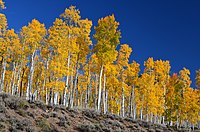
Photo from wikipedia
Aim: Large tropical trees form the interface between ground and airborne observations, offering a unique opportunity to capture forest properties remotely and to investigate their variations on broad scales. However,… Click to show full abstract
Aim: Large tropical trees form the interface between ground and airborne observations, offering a unique opportunity to capture forest properties remotely and to investigate their variations on broad scales. However, despite rapid development of metrics to characterize the forest canopy from remotely sensed data, a gap remains between aerial and field inventories. To close this gap, we propose a new pan‐tropical model to predict plot‐level forest structure properties and biomass from only the largest trees. Location: Pan‐tropical. Time period: Early 21st century. Major taxa studied: Woody plants. Methods: Using a dataset of 867 plots distributed among 118 sites across the tropics, we tested the prediction of the quadratic mean diameter, basal area, Lorey's height, community wood density and aboveground biomass (AGB) from the ith largest trees. Results: Measuring the largest trees in tropical forests enables unbiased predictions of plot‐ and site‐level forest structure. The 20 largest trees per hectare predicted quadratic mean diameter, basal area, Lorey's height, community wood density and AGB with 12, 16, 4, 4 and 17.7% of relative error, respectively. Most of the remaining error in biomass prediction is driven by differences in the proportion of total biomass held in medium‐sized trees (50–70 cm diameter at breast height), which shows some continental dependency, with American tropical forests presenting the highest proportion of total biomass in these intermediate‐diameter classes relative to other continents. Main conclusions: Our approach provides new information on tropical forest structure and can be used to generate accurate field estimates of tropical forest carbon stocks to support the calibration and validation of current and forthcoming space missions. It will reduce the cost of field inventories and contribute to scientific understanding of tropical forest ecosystems and response to climate change.
Journal Title: Global Ecology and Biogeography
Year Published: 2018
Link to full text (if available)
Share on Social Media: Sign Up to like & get
recommendations!